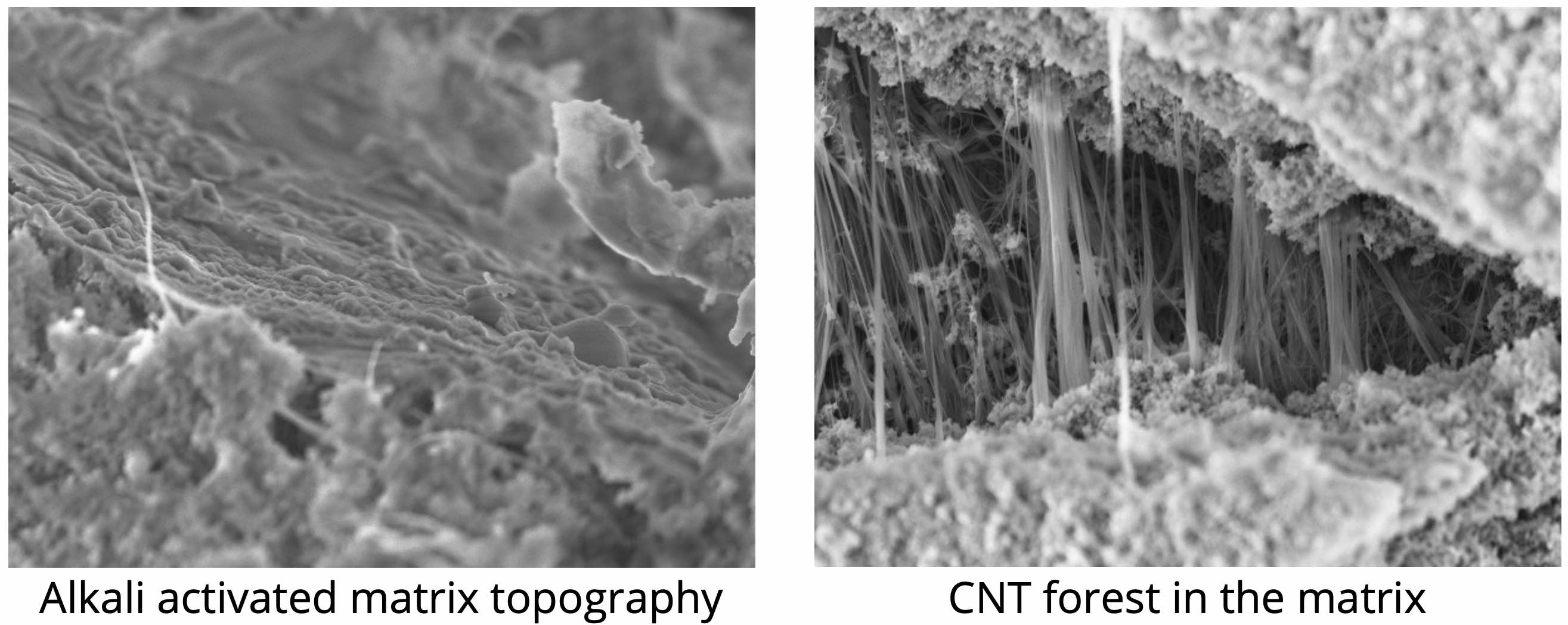
Alkali-activated composites are the low-carbon generation of construction materials. This class of material with their proven performances can be utilized for the construction of critical infrastructures. They are formulated to accomplish a high mechanical strength and chemical-thermal resistance. Alkali activated materials are produced by the reaction of precursors with alkaline activators. Precursors are multi-oxide components from industrial wastes streams or by-products and activators are made of alkali silicates or hydroxides. The fabricated composites out of such chemistry of components represent unique phases as illustrated in the figure.
The necessity of utilization of a novel multifunctional material in the core of civil industry motivates this research. The aim of proposed study is the development of a structural chemiresistor for real-time structural health interrogation and monitoring. The sensor is composed of a waste-originated alkali activated material as matrix and carbon nanotubes (CNT) as conductive additive. The first phase of the research was already done in Dresden Center for Nanoanalysis (DCN). A prototype nanocomposite was developed with an engineered methodology for more effective incorporation of CNTs within the microstructure of material. The CNT forest (third figure) is one of the spectacular phenomenon that was observed within the interior structure of the alkali activated nanocomposite. To put one step forward, the nanocomposite should represent smart characteristics and sense the analytes available in real conditions, e.g., around foundations, underground or marine infrastructures. Since the presence of water around the concrete structures is one of the main reasons of corrosion and deterioration of the structure, developed sensor should be able to sense the presence of moisture and discriminate between ion-containing liquids. Mentioned goal can be achieved by the manipulation of the micro- and nano-structures of nanocomposites.
Tasks:
• Modification of alkali activated chemiresistors to be multifunctional;
• Characterizing the mechanical and chemical properties of the new material;
• Assessing the sensor responses in exposure to introduced analytes;
• Improving discrimination capability of the sensor;
• Documenting the discoveries and publishing the best outcomes.
Requirements:
• Being enrolled in a Material Science, Engineering, or Natural Science curriculum;
• Having a very good command of English;
• Being creative and independent;
• Interested to do a hard work in the laboratory.
Benefits:
• Learning how to manufacture alkali activated nanocomposites and chemiresistors;
• Experiencing multidisciplinary nanomaterial research and development in a collaboration between the Institute of Materials Science and the Institute of Construction Materials;
• Working in the facilitated environment of the Dresden Center for Nanoanalysis (DCN);
• Working in the Alfred-Hütter laboratory for mechanical characterizations.

Alkali-activated composites are the low-carbon generation of construction materials. This class of material with their proven performances can be utilized for the construction of critical infrastructures. They are formulated to accomplish a high mechanical strength and chemical-thermal resistance. Alkali activated materials are produced by the reaction of precursors with alkaline activators. Precursors are multi-oxide components from industrial wastes streams or by-products and activators are made of alkali silicates or hydroxides. The fabricated composites out of such chemistry of components represent unique phases as illustrated in the figure.
The necessity of utilization of a novel multifunctional material in the core of civil industry motivates this research. The aim of proposed study is the development of a structural chemiresistor for real-time structural health interrogation and monitoring. The sensor is composed of a waste-originated alkali activated material as matrix and carbon nanotubes (CNT) as conductive additive. The first phase of the research was already done in Dresden Center for Nanoanalysis (DCN). A prototype nanocomposite was developed with an engineered methodology for more effective incorporation of CNTs within the microstructure of material. The CNT forest (third figure) is one of the spectacular phenomenon that was observed within the interior structure of the alkali activated nanocomposite. To put one step forward, the nanocomposite should represent smart characteristics and sense the analytes available in real conditions, e.g., around foundations, underground or marine infrastructures. Since the presence of water around the concrete structures is one of the main reasons of corrosion and deterioration of the structure, developed sensor should be able to sense the presence of moisture and discriminate between ion-containing liquids. Mentioned goal can be achieved by the manipulation of the micro- and nano-structures of nanocomposites.
Tasks:
• Modification of alkali activated chemiresistors to be multifunctional;
• Characterizing the mechanical and chemical properties of the new material;
• Assessing the sensor responses in exposure to introduced analytes;
• Improving discrimination capability of the sensor;
• Documenting the discoveries and publishing the best outcomes.
Requirements:
• Being enrolled in a Material Science, Engineering, or Natural Science curriculum;
• Having a very good command of English;
• Being creative and independent;
• Interested to do a hard work in the laboratory.
Benefits:
• Learning how to manufacture alkali activated nanocomposites and chemiresistors;
• Experiencing multidisciplinary nanomaterial research and development in a collaboration between the Institute of Materials Science and the Institute of Construction Materials;
• Working in the facilitated environment of the Dresden Center for Nanoanalysis (DCN);
• Working in the Alfred-Hütter laboratory for mechanical characterizations.